Speed / rates of change
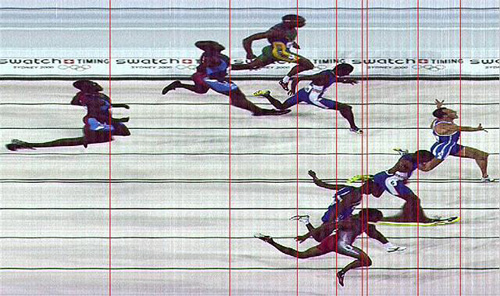
A photo-finish camera clocks Greece's Konstantinos Kenteris winning the men's 200-meter final with a time of 20.09 seconds at the Sydney Olympic Games, Sept. 28, 2000. Photo: Reuters / Corbis It's the torso that counts!
Speed
$$\text{average speed} =\frac{\Delta d}{\Delta t}$$ Average speed is distance travelled divided by time taken.
Konstantinos' speed for 200 meters: $$\text{speed}=\frac{200\text{ m}}{20.09\text{ s}}=9.96\text{ m/s}\approx 10\text{ m/s}$$
You can convert speed in one set of units to speed in a different set of units: Google "10 m/s in miles/hr".
But you can't convert speed into e.g. weight.
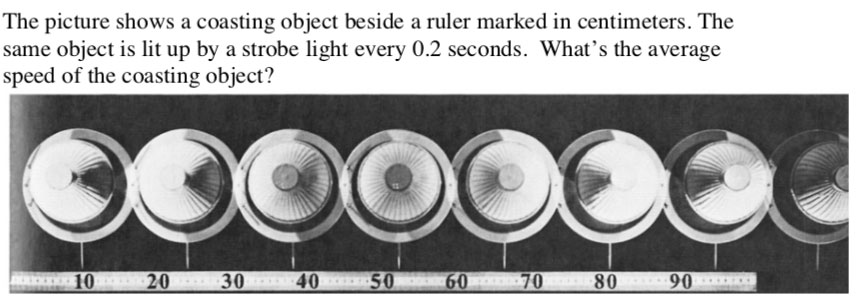
Graphing distance and time
Here's a graph of distance ($y$ axis) vs time ($x$ axis) for a top-flight 100 m dash runner:
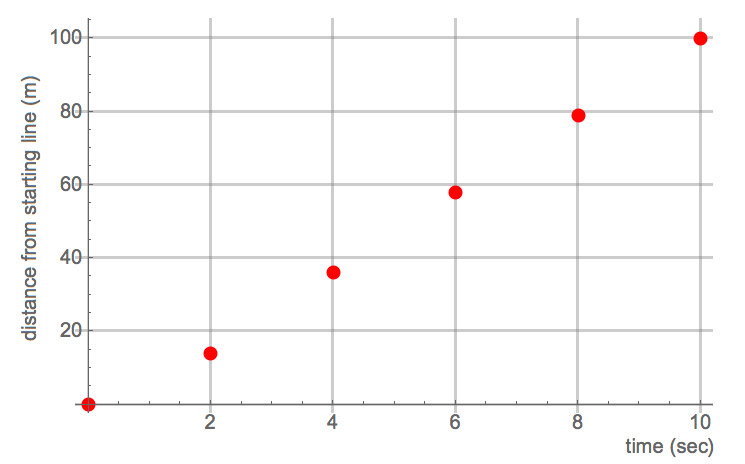
- What was the runner's average speed for the whole (100 m) race?
- Estimate the runner's average speed between 0 and 2 seconds...
The ratio you calculate for the average speed is the same as the "rise over run" formula used to calculate the slope of a line connecting two points, *any* two points, on the graph:
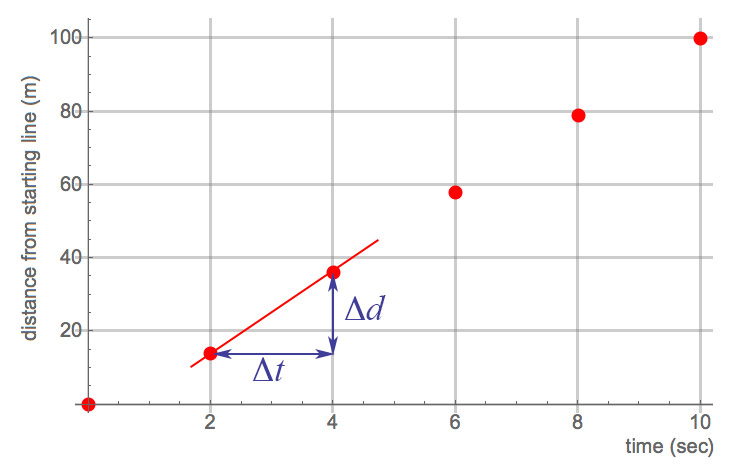
[Writing: about speed]

Answers:
1.) The object has moved from 10 cm to 94 cm, in 6 "flashes" of the strobe. So its speed is: $$\text{speed}=\frac{\Delta d}{\Delta t}= \frac{84\text{ cm}}{6*(0.2\text{ s})}=\frac{84}{1.2}=70 \text{ cm/sec}.$$
2.) 10 minutes is 1/6 of an hour, so their speed (in mph) is: $$\frac{\Delta d}{\Delta t}=\frac{1.5\text{ mi}}{1/6\text{ hr}}=\frac{1.5*6}{1}=9 \text{ mi/hr}.$$
3.) You can calculate their speed on the way back as $1.5$ mi/$(1/3) hr=4.5 mi/hr. It is tempting to average the speed on the way there with the speed on the way back and conclude the average speed was (4.5+9)/2=6.75 mi/hr.
But taking the total distance travelled (3.0 miles) and dividing by the total time it took (1/2 hour) =6 mi/hr, gives a different answer. *This* is the answer that is closer to the definition of average speed: total distance travelled divided by total time it took.
Now try this one:
"Joe sits in a traffic jam for one hour (speed=0 mph). It breaks up, and he drives at 60 mph for five hours (60 mph). How far did he travel? What was his average speed?"
Taking the average of the speeds gives an average speed of 30 mph.
To figure distance travelled, we rearrange "speed=$\Delta d/\Delta t$" to get get $$\text{speed} \times \Delta t= \Delta d$$ $\Delta d$ is distance travelled.
Travelling for 6 hours at an average speed of 30 mph should take you a distance of 180 miles.
But in fact Joe travelled a total distance of (5 hr)*(60 mi/hr)=300 miles. Dividing this total distance by total time (6 hours) = average speed of 50 mph which is the correct average speed.
Rates of change
Whenever the $x$ axis represents time, then the slope of the graph represents the rate of change of the quantity on the $y$ axis.
We say that speed is the rate of change of distance with respect to time.
Changes in groundwater
The graphs below are from the GRACE satellites (a joint operation of NASA and the German space agency). They use gravity to measure changes in water stored (WS or TWS="total water storage") month-by-month, over the course of several years.
The satellite data has been gridded, such that one graph represents the change in water storage in a 1${}^o$ latitude by 1${}^o$ longitude area (a "pixel" on the Google Earch image we'll see next week). A "1 cm" increase means that the change in gravity was the same as adding 1 cm of water over the whole 1${}^o$ by 1${}^o$ area. The satellite can't tell if the water stored is in the soil, in rivers and lakes, or in sub-surface aquifers (reservoirs) of water.

Here's an archive of trends in TWS for a variety of locations in the world.
*Speed* vs time graph
From the distance vs time graph, I...
- calculated the average speed for each 2-second interval, and,
- Graphed that speed at the time for the middle of the interval.
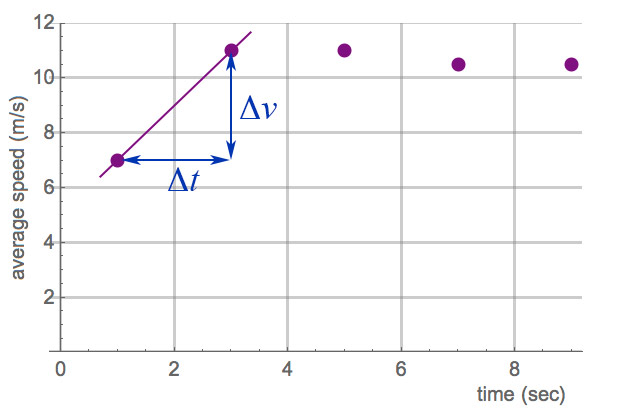
The ratio of change of speed, $\Delta v$, to change of time, $\Delta t$, corresponds to the slope of a line connecting two points. We call this quantity...
$$\text{average acceleration}=\frac{\Delta v}{\Delta t}.$$
- For which intervals in the graph above is the acceleration positive? negative? zero?
- What are the units of acceleration?
- What was the average acceleration from 1 to 9 seconds?
[writing] acceleration practice.
When you hear people talk about...
- speed it usually means "average speed, measured on a small time interval".
- acceleration it usually means "average acceleration, measured on a small time interval".